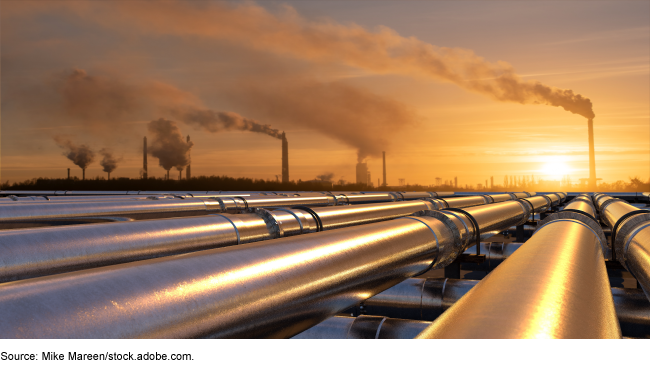Gas Pipelines: Oversight of Operators' Plans to Minimize Methane Emissions
Fast Facts
Methane, the primary component of natural gas and a potent greenhouse gas, can be emitted from gas pipelines through unintentional leaks or through intentional gas releases associated with maintenance and emergency response activities.
In 2020, Congress began requiring pipeline operators to update their plans and procedures for minimizing leaks or releases of methane. The Pipeline and Hazardous Materials Safety Administration or a certified state authority must review these updated plans.
In this Q&A, we reported that most of the reviews were done by the end of 2022 and generally found the operators had complied with the requirements.

Highlights
What GAO Found
The Protecting our Infrastructure of Pipelines and Enhancing Safety Act of 2020 (PIPES Act of 2020) included requirements for operators of pipeline systems to update their plans and procedures to address minimizing releases of natural gas. The act also required the Pipeline and Hazardous Materials Safety Administration (PHMSA) or the appropriate state authority to review these updated plans. To carry out this requirement, PHMSA notified pipeline operators of the requirement, developed guidance and training for federal and state pipeline inspectors, conducted outreach to the public, and reviewed operators' updated plans.
The primary challenge for pipeline operators updating their plans was the uncertainty of how to address the PIPES Act of 2020 requirements, according to selected operators and industry associations. PHMSA issued a proposed rule on leak detection and repair that includes more prescriptive and detailed requirements for addressing leaks.
PHMSA officials said six states had not completed their reviews, as of May 2024. PHMSA officials and state inspectors we spoke with most frequently cited challenges related to completing the reviews with existing resources in the allotted time, and potential gaps in states' abilities to enforce the requirements in the act. PHMSA officials said inspectors can incorporate future reviews of the plans into other scheduled inspections. They also noted that PHMSA's proposed rule on leak detection and repair will help fill the gap in enforcement authority for states.
Stakeholders GAO spoke with—including representatives from selected pipeline industry and safety groups, state regulatory officials, and gas pipeline operators—identified actions that could further reduce leaks from pipelines without compromising safety. These actions include improving "Call Before You Dig" programs that locate and mark underground utilities to help reduce excavation damage, updating certain operating procedures, adopting advanced technology, and replacing aging portions of certain pipelines. PHMSA has various efforts underway related to these areas.
Why GAO Did This Study
A 3-million-mile nationwide network of pipelines carries gas from producing wells to processing plants, and eventually to end users, such as manufacturers, businesses, and homes. Methane, the primary component of natural gas and a potent greenhouse gas, can be emitted from pipelines through unintentional leaks or through intentional releases of gas associated with maintenance and emergency response activities. According to PHMSA, emissions from gas pipeline systems are a risk to public safety and contribute to climate change.
The act also includes a provision for GAO to examine PHMSA's and states' reviews of pipeline operators' updated plans. This report includes information on the process PHMSA and states used to review operators' updated plans, operator and inspector challenges associated with updating and reviewing these plans, and selected stakeholders' views on ways to further minimize natural gas emissions from pipelines without compromising safety.
GAO reviewed applicable statutes, regulations, and agency documentation; interviewed PHMSA officials, selected state pipeline safety authorities, selected gas pipeline operators; and relevant stakeholders, such as industry associations, pipeline safety and environmental groups.
For more information, contact Elizabeth Repko, Director, Physical Infrastructure at (202) 512-2834 or RepkoE@gao.gov.
